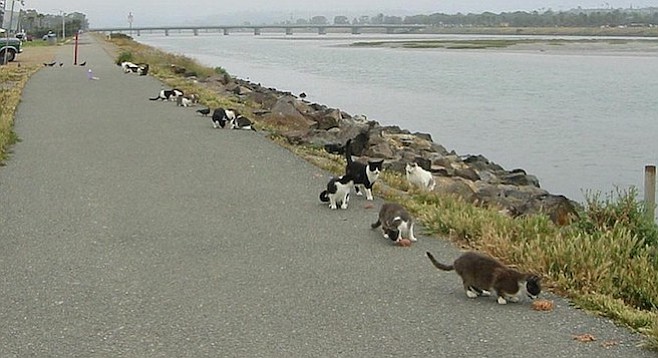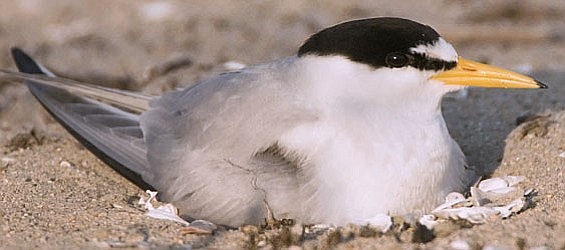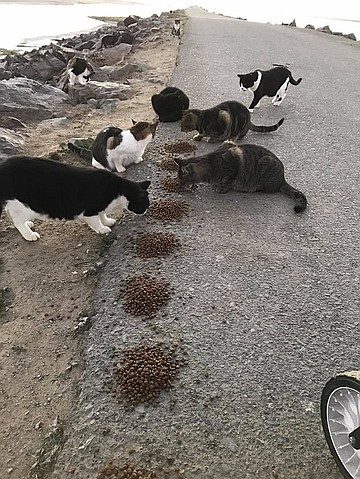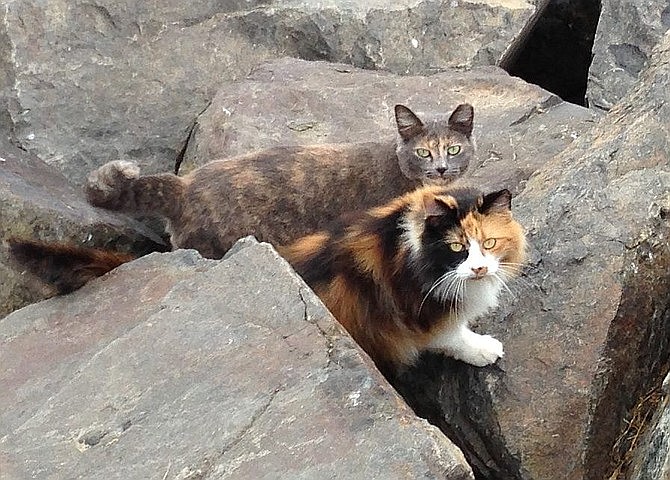 Facebook
Facebook
 X
X
 Instagram
Instagram
 TikTok
TikTok
 Youtube
Youtube

A petition addressed to mayor Kevin Faulconer is making the rounds, asking him to overturn an agreement with the U.S. Department of Agriculture to round up and kill feral cats. The petition points to one cat colony in particular — the “jetty cats” of Mission Bay.

On December 23, 2016, the city posted a notice regarding the “predator management” program. The notice stated the main focus of the program is to protect the endangered California least terns and their nests from predatory animals at nesting sites through Mission Bay. The notice states that actions against potential predators (including feral cats) can include, but are not limited to: monitoring, trapping, dispersal, and shooting.
Amber Millen from the Feral Cat Coalition spoke to me about her part in managing the feral cats at the jetty. She said that her group and East County Animal Rescue trapped all the cats about eight years ago to spay and neuter. There were more than 80 cats at the time, she said.

“East County Animal Rescue took at least 12 kittens in to get socialized and adopted into homes,” said Millen. “The rest of the cats were either feral or not candidates for homes so they were returned to the jetty after being fixed, vaccinated, and ear tipped.” All cats at the jetty have their ears "tipped" — a quarter inch or so clipped while sedated — for easy identification.
“The population has gone down over the years as cats died of old age, were adopted, or disappeared. There are now less than 30 cats in the area.”
Millen said that caretakers feed them every day and trap cats as needed for medical attention.
Millen said the jetty isn’t one of the city’s target sites, so the jetty cats aren’t currently at risk, but there are potentially cats in danger nearby.
“All the news agencies focus on [the jetty cats] because they know they can get them on camera. The city claims no cats were trapped and killed in the last two years.” While Millen hopes this is true, she points out that this program has been going on for at least a decade, so it’s possible cats have been trapped and killed in the past.
Millen said the city bringing cats into the shelter is no solution since they’re either euthanized or relocated. She said the latter is almost never successful and just leads to more unfixed cats taking their place.
“This is very stressful on the poor dumped cat,” said Millen. “We had a pure white cat dumped before, and she had horrible sunburns within a week because her pale skin was so sensitive to the elements. She was terrified, so it took us some time to catch her so we could get her into a home.”
Millen said the San Diego Humane Society and the Sierra Club have filed appeals to the city’s program in hopes of it being revised to be more humane.
Tim Graham from the city’s parks department said the predator management program has been in existence for more than 25 years. Graham said it's conducted each year from April until September. He also said it's limited to only four sites in Mission Bay.
“As to the impact of the program on feral cats, the existing policy is that all cats, domesticated or feral, that are found in Mission Bay as part of this program are sent to the Humane Society on Gaines Street and steps are taken to notify the owners if any cats are found with a collar.” He said that no cat has been caught in the past two years as part of this program.
When asked about the purpose of the public notice in December 2016, he said the city was in the process of renewing its predatory management agreement.
Dan DeSousa, deputy director of the county’s Department of Animal Services, couldn’t give me a breakdown of cats from the Mission Bay jetty that have come into the shelter in recent years because numbers are categorized only by zip code. As far as the fate of feral cats that end up at shelters, DeSousa said if they see the tipped ear, they contact the Feral Cat Coalition so they can reclaim the cat. For other feral cats, they contact other rescue organizations. “Absent the few feral cats that are adopted or sent to [Feral Cat Coalition], most are unfortunately euthanized.”

I talked to a volunteer while she was feeding four jetty cats after sunset. She’s been volunteering for about five years and said there are seven cats at the most in this one area with maybe forty down the jetty. “I only feed these ones at night because they’re very shy and only come out at night.”
The volunteer instructed me to stay back. “Trusting humans is dangerous for them. I don’t care if they ever like me or not; it’s better that they don’t…it keeps them safe. We don’t want the kitties to be too friendly because there are people around that are really mean.”
Case in point is a man in his 60s who she said destroys the cats’ water bowls all the time; three weeks ago she saw him about to do it again, but he stopped when they made eye contact.
Steve Roche told me about another local cat-hater from times past. “Back in the early 1960s, there was a guy who had a personal cat-eradication program. We called him ‘the Catman.’ He would throw burlap bags of cats with rocks into the channel and they would drown. We kids were terrified of him. He was a skinny, hunchback kind of guy.”
As she watched the last cat eat its dinner, the volunteer told about the 14-year-old jetty cat she recently adopted. “Feral cats are just cats. If you adopt one, you’ll find they’re so loving and appreciative. You have to just leave them alone for a few days or even weeks. Wait for them to adapt to the change; they don’t know what life in a home is. Just give them a corner with a bed, food, and water. They won’t try to escape. The one I have, she doesn’t care to go outside at all, she’s so happy to be inside finally.”
She said that anyone who would like to volunteer or adopt a jetty cat should contact someone at Jetty Cat-San Diego via Facebook. They’re the only ones who know how to catch them, she said. She warns against trying to get too close, especially at dinner time, because then the skunks get their food.


A petition addressed to mayor Kevin Faulconer is making the rounds, asking him to overturn an agreement with the U.S. Department of Agriculture to round up and kill feral cats. The petition points to one cat colony in particular — the “jetty cats” of Mission Bay.

On December 23, 2016, the city posted a notice regarding the “predator management” program. The notice stated the main focus of the program is to protect the endangered California least terns and their nests from predatory animals at nesting sites through Mission Bay. The notice states that actions against potential predators (including feral cats) can include, but are not limited to: monitoring, trapping, dispersal, and shooting.
Amber Millen from the Feral Cat Coalition spoke to me about her part in managing the feral cats at the jetty. She said that her group and East County Animal Rescue trapped all the cats about eight years ago to spay and neuter. There were more than 80 cats at the time, she said.

“East County Animal Rescue took at least 12 kittens in to get socialized and adopted into homes,” said Millen. “The rest of the cats were either feral or not candidates for homes so they were returned to the jetty after being fixed, vaccinated, and ear tipped.” All cats at the jetty have their ears "tipped" — a quarter inch or so clipped while sedated — for easy identification.
“The population has gone down over the years as cats died of old age, were adopted, or disappeared. There are now less than 30 cats in the area.”
Millen said that caretakers feed them every day and trap cats as needed for medical attention.
Millen said the jetty isn’t one of the city’s target sites, so the jetty cats aren’t currently at risk, but there are potentially cats in danger nearby.
“All the news agencies focus on [the jetty cats] because they know they can get them on camera. The city claims no cats were trapped and killed in the last two years.” While Millen hopes this is true, she points out that this program has been going on for at least a decade, so it’s possible cats have been trapped and killed in the past.
Millen said the city bringing cats into the shelter is no solution since they’re either euthanized or relocated. She said the latter is almost never successful and just leads to more unfixed cats taking their place.
“This is very stressful on the poor dumped cat,” said Millen. “We had a pure white cat dumped before, and she had horrible sunburns within a week because her pale skin was so sensitive to the elements. She was terrified, so it took us some time to catch her so we could get her into a home.”
Millen said the San Diego Humane Society and the Sierra Club have filed appeals to the city’s program in hopes of it being revised to be more humane.
Tim Graham from the city’s parks department said the predator management program has been in existence for more than 25 years. Graham said it's conducted each year from April until September. He also said it's limited to only four sites in Mission Bay.
“As to the impact of the program on feral cats, the existing policy is that all cats, domesticated or feral, that are found in Mission Bay as part of this program are sent to the Humane Society on Gaines Street and steps are taken to notify the owners if any cats are found with a collar.” He said that no cat has been caught in the past two years as part of this program.
When asked about the purpose of the public notice in December 2016, he said the city was in the process of renewing its predatory management agreement.
Dan DeSousa, deputy director of the county’s Department of Animal Services, couldn’t give me a breakdown of cats from the Mission Bay jetty that have come into the shelter in recent years because numbers are categorized only by zip code. As far as the fate of feral cats that end up at shelters, DeSousa said if they see the tipped ear, they contact the Feral Cat Coalition so they can reclaim the cat. For other feral cats, they contact other rescue organizations. “Absent the few feral cats that are adopted or sent to [Feral Cat Coalition], most are unfortunately euthanized.”

I talked to a volunteer while she was feeding four jetty cats after sunset. She’s been volunteering for about five years and said there are seven cats at the most in this one area with maybe forty down the jetty. “I only feed these ones at night because they’re very shy and only come out at night.”
The volunteer instructed me to stay back. “Trusting humans is dangerous for them. I don’t care if they ever like me or not; it’s better that they don’t…it keeps them safe. We don’t want the kitties to be too friendly because there are people around that are really mean.”
Case in point is a man in his 60s who she said destroys the cats’ water bowls all the time; three weeks ago she saw him about to do it again, but he stopped when they made eye contact.
Steve Roche told me about another local cat-hater from times past. “Back in the early 1960s, there was a guy who had a personal cat-eradication program. We called him ‘the Catman.’ He would throw burlap bags of cats with rocks into the channel and they would drown. We kids were terrified of him. He was a skinny, hunchback kind of guy.”
As she watched the last cat eat its dinner, the volunteer told about the 14-year-old jetty cat she recently adopted. “Feral cats are just cats. If you adopt one, you’ll find they’re so loving and appreciative. You have to just leave them alone for a few days or even weeks. Wait for them to adapt to the change; they don’t know what life in a home is. Just give them a corner with a bed, food, and water. They won’t try to escape. The one I have, she doesn’t care to go outside at all, she’s so happy to be inside finally.”
She said that anyone who would like to volunteer or adopt a jetty cat should contact someone at Jetty Cat-San Diego via Facebook. They’re the only ones who know how to catch them, she said. She warns against trying to get too close, especially at dinner time, because then the skunks get their food.